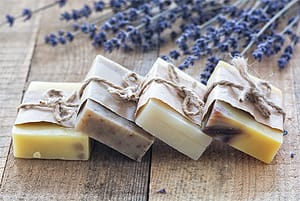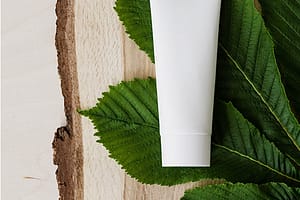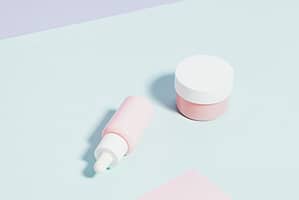
What Are They and How Do They Work?
Emulsifiers are amphiphilic molecules used in formulations to facilitate the mixing of oils and water. They contain both a polar hydrophilic head group and a non-polar hydrophobic tail. When added to O/W emulsions, emulsifiers surround the oil droplets with their non-polar tails extending into the oil and polar head groups facing the water. For W/O emulsions, this orientation is reversed. They reduce the surface tension between two phases, keeping the oil suspended in water and vice versa.
For content about the use of cosmetics ingredients, read our article on the Applications of Essential Oils
Emulsifiers vs Solubilisers
Solubilisers are very much like emulsifiers. However, the key difference is that solubilisers are completely water soluble with a little oil solubility while emulsifiers are not water soluble. Solubilsers are typically used to achieve transparent or lightly translucent solutions compared to the opaque creams that emulsifiers provide.
Both emulsifiers and solubilisers are part of the surfactant family and they disperse oils in water. Due to certain similarities, these terms are often confusing for formulators that are just getting started. They function differently and cannot be used interchangeably hence; it is important to understand their differences to make informed choices when selecting which to use.
How Are They Different?
|
Property
|
Emulsifiers
|
Solubilisers
|
|---|---|---|
|
Solubility
|
Not water soluble
|
Completely water soluble with a little oil solubility
|
|
End product appearance
|
Milky or turbid
|
Clear or translucent
|
|
Particle size
|
Micrometre range
|
Low micrometre to nanometre range
|
|
Used for
|
Big lipophilic molecules
|
Small molecules like essential oils
|
|
Working temperature
|
May need heating or melting
|
Usually works at room temperature
|
|
Mechanical force
|
High mechanical force needed
|
Low mechanical force needed
|
|
Oil phase concentration
|
0 to 50%
|
0.1 to 2%
|
How to Select the Right Emulsifier?
Calculating the HLB value is one way. The Hydrophilic-Lipophilic Balance, also known as the HLB value in short, is used as a measure of the ratio of hydrophilic (water-loving) and lipophilic (fat-loving) moieties of a surfactant molecule. The HLB system is particularly useful to identify surfactants for emulsions. HLB value ranges from 0-20.
O/W Emulsion
Oil dispersed in water
Requires high HLB surfactants
HLB Range: 8.0 – 18.0
W/O Emulsion
Water dispersed in oil
Requires low HLB surfactants
HLB Range: 2.0 – 6.0
How to Calculate the HLB Value?
Example: What is the HLB value of the mixture of 40% Span-60 (HLB = 4.7) and 60% Tween60 (HLB = 14.9)?
Calculation: 4.7 x 0.4 + 14.9 x 0.6 = 10.8
What is the Relationship between HLB Value and the Use of Emulsifiers and Solubilisers?
|
HLB Value
|
Dispersion Characteristics
|
|---|---|
|
1 - 4
|
No dispersability in water
|
|
3 - 6
|
Poor dispersion
|
|
6 - 8
|
Milky dispersion after vigorous agitation
|
|
8 - 10
|
Stable milky dispersion
|
|
10 - 13
|
Translucent to clear dispersion
|
|
13+
|
Clear solution
|
|
HLB Value
|
Application
|
|---|---|
|
2 - 6
|
W/O emulsion
|
|
7 - 9
|
Wetting agent
|
|
8 - 18
|
O/W emulsion
|
|
12 - 15
|
Detergent
|
|
15 - 18
|
Solubiliser
|
Formulation: Anti-aging Emulsion Cream
|
Phase
|
Product Name
|
INCI Name
|
% W/W
|
|---|---|---|---|
|
A
|
Water
|
Water
|
85.2
|
|
Glycerine USP 99
|
Glycerin
|
3.0
|
|
|
Natori PGA 92 (700KDA)
|
Polyglutamic Acid
|
0.5
|
|
|
Natori Phyto Collagen 0.1C HD
|
Hydrolyzed Extensin, 1,2-Hexanediol
|
3.0
|
|
|
Synthalan E80
|
Carbomer
|
0.5
|
|
|
AMP95
|
AMP95
|
0.1
|
|
|
B
|
Emulri SA
|
Strearic Acid
|
1.0
|
|
1.0
|
|||
|
1.0
|
|||
|
Scentori Soybean Oil
|
Soybean Oil
|
2.0
|
|
|
2.0
|
|||
|
C
|
0.3
|
||
|
D
|
Superscent FR-221256
|
Fragrance
|
0.4
|
|
E
|
Citric Acid
|
Citric Acid
|
q.s.
|
For Bar Soap Formulation, check out our article on Sustainable Bar Soap and Its Benefits!
For spring-themed products formulation, check out our article on Prep for Spring, Switch Up Your Skin Care Routine!





